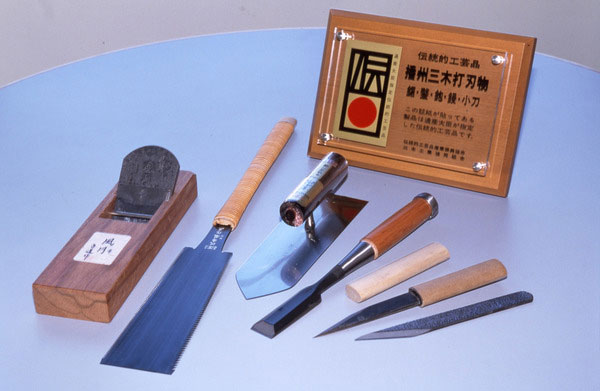
- Metal works
- Hyogo
Banshu-miki cutlery Banshu miki uchihamono
Shining blades made from repeated tempering
and Japanese traditional forging techniques
Description
What is Banshu-miki cutlery ?
Banshu Miki Uchihamono are metalwork produced around Miki City, Hyogo Prefecture. Like Shinshu Uchihamono and Tosa Uchihamono, Banshu Miki Uchihamono is renowned as a craft made using molding techniques. These areas are also known as large production centers of blades in Japan. Banshu Miki Uchihamono are distinguished by the wide variety of blades made using traditional manufacturing methods, from daily necessities such as knives, chisels and planes to large construction tools. Each item is carefully produced by hand.
History
The forging which is said to be the beginning of Banshu Miki Uchihamono, started about 1500 years ago. It originated when Korean blacksmiths from the ancient Korean kingdom Paekche settled around the former Miki city where they exchanged skills with the Japanese blacksmiths. But Banshu Miki Uchihamono was established quite later in history. It is said that, the foundations of this traditional forging technique were established in the Edo period, and it was at this time that the crafts called Banshu Miki Uchihamono were born and developed into the form we know today. According to historical documents, it was in 1763 that the production of wide-bladed ripsaws was started and signs of the industry’s development were seen in Miki. In 1760, Edo (current Tokyo) was devastated by a large fire, creating a demand for reconstruction timber, and a consequent temporary demand for axes, saws and the like. However the history and survival of Banshu Miki Uchihamono has not always been so easy; the industry has faced several difficulties over the years, such as the loss of its exclusive distributorship in Osaka in 1792; and the rapid decrease of demand for traditional forging due to the introduction of western techniques around 1885. Despite such setbacks, the skills of Banshu Miki Uchihamono have been continuously passed down through the efforts of generations of craftsmen.
General Production Process
- 1. Forge Welding
The iron base is heated to a high temperature of about 1,200°C and is joined with carbon steel using a bonding agent including borax. A too high or low temperature results in poor bonding of metal. Therefore the artisan must keep an eye on the temperature.
- 2. Forging: Beating the edge of the blade
The edge and tip of the blade are forged. The iron base covered with carbon steel is beaten thoroughly and repeatedly to tightly combine the two metals. As the forged blade becomes quite big, it is cut to size.
- 3. Forging: Beating the center of the blade
The center of the blade (the opposite side of the edge) is forged while paying careful attention to the temperature. This is followed by the creation of the tang to fit into the handle.
- 4. Smith forging
The forged blade is again put into the fire to firm the shape. As chisel blades have thin edges, too much heating decreases the strength of the blade. Smith forging requires strict heat control at a temperature between 950°C and 1,000°C. The heated blade is then forged again to adjust the thickness and width.
- 5. Annealing
Annealing is carried out by placing the blade in straw ashes and heating at a low temperature of about 750℃. Annealing is done to crystallize the carbon steel and make it easier to file.
- 6. Grinding
After annealing, the carbon steel is soft enough to be sharpened with a file and the shape is adjusted by grinding. First, rough sharpening is done so that the center part becomes round. Next, the back of the blade is roughly planed. The surface is planed smooth by buffing, or polishing while rotating with a round cloth and polishing agent.
- 7. Quenching
The polished steel is heated again for a few minutes at a low temperature between 700ºC and 800℃. Then the steel is cooled down by quickly plunging into water. Unlike the previous heating processes, polishing powder is applied on the surface when quenching. This makes the strength of the blade even and brings out the beauty of the blade.
- 8. Tempering
After hammering out the deformations from quenching, tempering is carried out. This is an important process as it brings out the lustre of the blade. First, the blade is tempered with oil and rinsed with water. Next, it is placed in salt at a temperature of 150℃ and then tempered again.
- 9. Final polishing
The blade, which is heated, forged, and tempered repeatedly, is then polished again in the final process. The blade becomes sharp by carefully polishing the edge and tip.
Where to Buy & More Information
Miki Hardware Museum
-
Address
-
Tel.+81-794-83-1780
-
ClosedMondays (open if Monday is holiday and closed the next day), December 29 to January 3
-
Business Hours10am to 5pm
-
Website
See more Metal works
- Nambu ironware
- Takaoka copperware
- Yamagata cast iron
- Sakai cutlery
- Tokyo silverware
- Echizen cutlery
- Osaka naniwa pewterware
- Tosa cutlery
- Tsubame-tsuiki copperware
- Shinshu Forged Blades
- Banshu-miki cutlery
- Higo inlays
- Echigo-sanjo cutlery
- Echigo-yoita cutlery
- Chiba Artisan Tools
- Tokyo antimony craft































































































































































































































































































